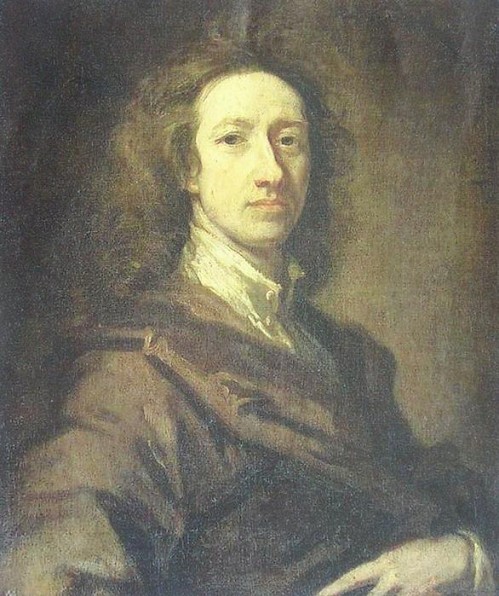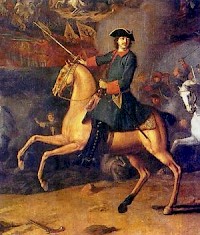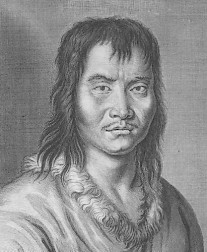Cornelis de Bruijn
Cornelis de Bruijn (c.1652-1727) was a Dutch artist and traveler. He is best known for his drawings of the ruins of Persepolis, the first reliable pictures of these palaces to be accessible for western scholars. His other visits included the Ottoman Empire, Egypt, Jerusalem, Russia, and the East Indies.
Russia

He returned in 1708 and published an account of his adventures in Reizen over Moskovie, door Persie en Indie ("Travels into Moscovy, Persia, and the East Indies"). This book is our main source for De Bruijn's second travel.
Since the planning of this trip had begun, the political situation had changed. In the past century, the power of Sweden had grown and in 1700, Denmark and Saxony-Poland had attacked the Swedish possessions to the south and east of the Baltic Sea, hoping to win back what they had once lost. This was the beginning of the Great Northern War.note Tsar Peter joined the aggressors, because he needed a warm-water port to give his country a "window on Europe".
War in the Baltic: under normal circumstances, the Dutch would have sent ships into the Baltic to maintain the balance of power and keep the grain prices low, but this was impossible. In 1701, the War of Spanish Successionnote had started when Louis XIV of France made his brother king of Spain. This would seriously endanger the balance of power. William III created an alliance of England, the Dutch Republic, the emperor Leopold I of Austria, Portugal, Hannover, and Prussia, which -in the end- successfully contained France. However, the two wars marked the end of the cheap cereals that were essential for Dutch prosperity. When De Bruijn returned, only a few people had the money to buy his new book.

But this was still in the future. In 1701, the outbreak of war only meant that De Bruijn could not take the land route to Berlin, Warsaw, and Moscow, but had to sail to the North Cape and enter Russia in Archangelsk. As a precaution against a Swedish naval attack, the Russians had removed al buoys, so that the ships of De Bruijn's convoy could not advance to the port. A longboat with the commanders of the ships (and Cornelis de Bruijn), tried to reach Archangelsk, but was unable to find it, "even though we had four captains aboard", as De Bruijn commented with his typical sense of understatement.
Finally, however, they reached Archangelsk, where De Bruijn could stay in the house of a Dutch merchant who was a friend of Nicolaes Witsen. De Bruijn spent a lot of time with anthropological research: his description of the culture of the Samoyedes, a nation that resembled the Laps but lived east of Archangelsk, was to become a classic and contains beautiful drawings.

After some time, De Bruijn continued his trip and joined a convoy to the south. After visits to Vologda and Yaroslavl, he reached Moscow in January 1702. Again, the recommendations by Nicolaes Witsen were useful: the traveling painter could stay in the house of the Dutch resident, Nicolaas van der Hulst, who lived near the Russian capital in a district for foreigners called Nemetskaja Sloboda.
Van der Hulst introduced De Bruijn to the czar, who was immediately interested and gave the artist permission to see whatever he liked. Witsen's idea that Peter needed an artist to show that his country was modernizing, was right, and never before had De Bruijn found travel so easy. He entered the tsar's palace, celebrated Easter, met Peter's friend Alexander Menshikov (1673-1729), slept in imperial datcha's, and was allowed to visit the military wharves of Voronezh on the Don.
The latter was clever propaganda: western politicians now knew that the Russian emperor could be a serious ally in a war against the Turks. In fact, Peter used De Bruijn to invite the western powers to make an alliance that might give Russia access to the Black Sea. The painter was useful in another way: he made paintings of the tsar's three nieces, which were sent to the European dynasts. Royal suitors were welcome in Moscow, was the message, and politicians would understand that a military alliance could also be obtained.
In Travels into Moscovy, Persia, and the East Indies, De Bruijn was to praise his host, but he focuses on only a couple of reforms, like technology and medicine. He did not lose his critical instinct and did not want to commit himself to a foreign ruler whose secret police was notorious.
In April 1703, De Bruijn left Moscow. Together with Jacob Davidov, an Armenian merchant who had lived in Amsterdam and wanted to visit his compatriots in Persia, the artist sailed down the river Oka to the east. On 1 May, he arrived in Kasimov. If communications had been faster, he might have learned that on that day, czar Peter had reached his war aim: he captured the Swedish fort at the mouth of the river Neva and gained access to the Baltic Sea. A few days later, when De Bruijn had already reached the river Volga, the czar renamed the conquered town St.Petersburg.
De Bruijn heard all this in the early summer, when he had reached the delta of the Volga in Astrakhan. Here, he painted a portrait of the son of the governor, and after several weeks, he boarded a ship that coasted along the western shore of the Caspian Sea until it reached Derbent (21 July), the port of Dagestan and in those days the gateway to Persia.